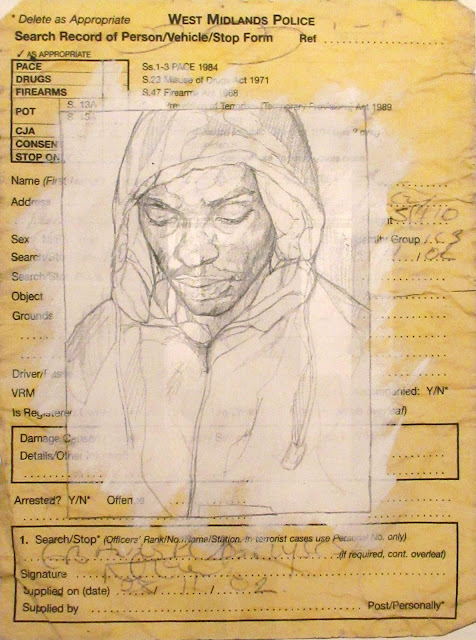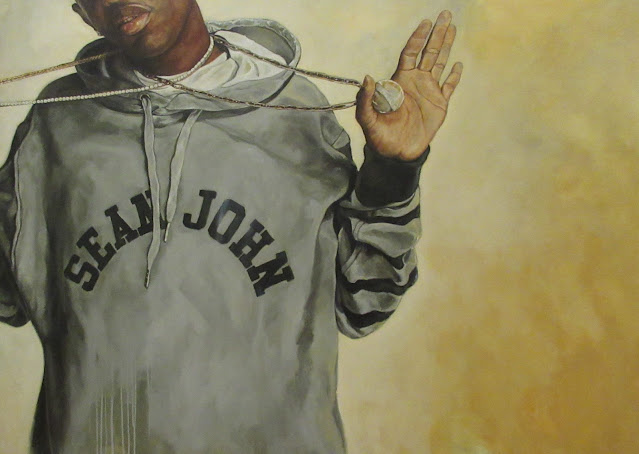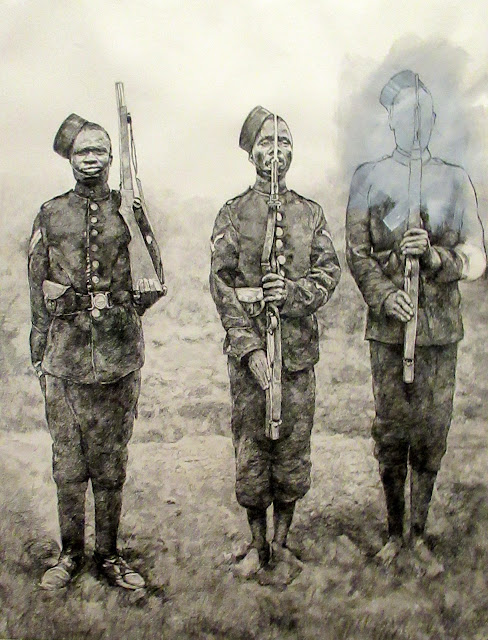Barbara Walker, Being Here
at the Whitworth Art Gallery, Manchester.
This is the second post on this exhibition and I have used the same introduction as in part 1, which is the paragraph below. In this post I have concentrated on the more explicitly political works of the artist.
This is the first survey of Walker's work and brings together over 70 artworks, spanning the last 25 years. From small, detailed drawings on archival documents to monumental wall drawings, Walker combines exquisite technical skill with a critical eye on the social and political realities that shape black lives in Britain today.Walker experiments with techniques of visibility and erasure - enlarging, cutting-out, obscuring - to speak truth to power and prompt us to consider how we can collectively shape black futures.
Louder than Words, 2006-09:
'Solomon is my son, and I remember when he was first stopped and searched like it was yesterday. I felt helpless, because as a parent you're there to protect your children, and I couldn't do anything to stop it.
He felt disrespected and embarrassed, and for me, it was the thought of him being dehumanised. He was angry, and I was too. I channelled that anger into the work. My emotions are very much embedded in these drawings. I see the search record as a kind of drawing done by the police officer, which is why I wanted to draw on it, to introduce the mother's hand'.This deeply personal series marks Walker's first use of the official document as an expanded form of portraiture. Here, drawing becomes her central medium of expression and methods of erasure, such as overpainting and obscuring, are introduced. Responding to her son being repeatedly stopped and searched by police, she impulsively began to draw him, and the locations the encounters took place, on to copies of the yellow police dockets that recorded the incidents. Walker digitally scans and enlarges the documents, transforming them into louder and more visible statements.
While these works are urgent and creative acts of love and care grounded in her position as a mother, they also confront wider concerns about the surveillance of black communities by the police.
Polite Violence II, 2006, (oil on archival inkjet)
Polite Violence III, 2006, (oil on archival inkjet)
I Can Paint a Picture with a Pin, 2006, (ink on digital image)
Untitled, 2006, (mixed media on digital image)
Brighter Future, 2006, (charcoal and conte on digital image)
Brighter Future and Brighter Future I, are created from enlargted scans of pages of the Independent newspaper from 25 July 2005. The article reports on the wrongful shooting of the 27 year old Brazilian man Jean Charles de Menezes by London Metropolitan Police. Walker draws tender portraits of her son over the newsprint, placing her personal story in dialogue with that of the parents of de Menezes who are pictured and quoted in the article.
Brighter Future I, 2006, (charcoal and conte on digital image)
Screen I, 2006, (charcoal on paper)
Screen II, 2006, (charcoal on paper)
Homegrown, 2006, (digital image)
Show and Tell, 2008-15:
Show and Tell continues Walker's focus on perceptions of the black male body. The series began in 2008 during a residency in Johannesburg, South Africa, where she invited people into her studio. She engaged them in conversation on themes of self-expression, fashion and identity, while photographing and drawing them from life. For Walker, the series considers 'stereotyping and how people are judged, looked upon or perceived through their clothing'.
Walker deliberately obscures the faces of her sitters. Instead, attention is drawn exclusively to the backs of their heads, or their dressed annd styled bodies. She asks us to engage in active viewing and reckon with our own perceptions and prejudices, encouraging us to be aware and critical of our own gaze.
B44, 2007, (oil on canvas)
Construct I, 2009, (oil on canvas)
The Dichotomy of Sean, 2012, (mixed media)
The Dichotomy of Sean and The Dichotomy of Kenny connect the profiling and criminalisation of racialised young men explored in both Show and Tell and Louder Than Words, to the tragic loss of innocent young lives in the early 2000s. The texts at the bottom of the compositions are statements from media reorts on the widely reported deaths of Jean Charles De Menezes and Trayvon Martin, a 17 year old killed by a neighbourhood watch volunteer in Florida in 2012. The everyday nature of the statements chosen by Walker emphasises the innocence and fragility of these lives.
The Dichotomy of Kenny, 2012, (mixed media)
Construct III, 2009, (oil on canvas)
Finito, 2012, (charcoal on paper)
Same Difference III, 2008, (charcoal on paper)
With the words 'I am...' repeated under the figure in this drawing, Walker references Glenn Lighon's 1988 painting Untitled (I Am a Man). Ligon's iconic work is a reinterpretation of the signs reading 'I Am a Man' carried by the 1,300 public service workers, all black men, who went on strike in Memphis, Tennessee in 1968 after two coworkers were killed due to unsafe working conditions. The slogan has become a powerful proclamation of humanity, dignity and justice.
'I always have one foot in history and one foot in contemporary practice. I always go back to history. I look back and re-enact history to go forward'.
This series marks a crucial archival turn in Walker's practice. Over several years, she carried out extensive research into national war archives, to recover the forgotten contributions of black service men and women to British and European war efforts. Encountering a lack of African and Caribbean presence in official records, she supplemented the gaps with material found on eBay and in personal family records.
The works in this series are reinterpretations of archival photographs relating mainly to WWI and WWII, but also including portraits of contemporary British soldiers. Using trechniques of erasure, such as blind embossed print, she powerfully disrupts the historical record. White European servicemen and women are rendered almost entirely absent, the African and Caribbean soldiers are now brought to the fore, portrayed in illuminating detail. In other instances, we see her signature use of the document as a social and political backdrop to her intensely observed portraits.
Josiah 2016, (conte on digital image)
The extensive media reporting on the war in Afghanistan prompted Walker to consider the contributions of black soldiers to the British armed forces. Charly and Josiah are portraits of two contemporary soldiers. Each are delicately drawn over reproductions of recruitment posters from WWI that targeted the British colonies to address labour shortages in the British army. Walker's placement of the contemporary portrait over the document reveals the forgotten involvement of African and Caribbean military personnel across time.
Charly, 2016, (conte on digital image)
Backdrop, 2018, (graphite on embossed paper)
Untitled, 2015, (charcoal and white paint)
I Was There I, 2018, (ink, gold leaf, vellum and tracing paper on digital print)
I Was There, 2018, (ink gold leaf, vellum and tracing paper on digital print)
I Was There, 2018, (ink, gold leaf, vellum and tracing paper on digital print)
Parade III, 2017, (graphite on embossed paper)
The Big Secret, 2016, (conte on paper)Burden of Proof, 2022-2023:
In 2023, Walker was nominated for the Turner Prize for Burden of Proof, a series of drawings which gave visibility to individuals impacted by the Windrush Scandal. The scandal emerged in 2017 and exposed how Caribbean migrants of the Windrush generation were wrongly classified as illegal immigrants. The journalist Amelia Gentleman describes the scandal in her book, The Windrush Betrayal, and shares the stories of several of the sitters represented here.
'Having placed the burden of proof on individuals, the Home Office demanded to see evidence that would prove their right to remain in the UK. These mundane, forgotten pieces of paper have now become the oppressive instruments to prove their legitimacy. Yet, the documents reveal how these individuals have contributed to this country. They're not statistics on a piece of paper, these are real lives. There's a deliberate tension in the overlapping of the documents with the figure in the drawing, reflecting how these documents became more important than the individuals'. Barbara Walker.
Walker sits these layered portraits alongside a monumental charcoal wall drawing of the sitters. As is now a ritual for Walker, the wall drawing will be washed away at the end of the exhibition. This act of erasure is a personal and private moment that the artist undertakes in a symbolic re-enactment of the erasure of history and memory.
Burden of Proof 7, 2022, (mixed media with graphite, conte and pastel on paper)
Burden of Proof 3, 2022, (mixed media with graphite, conte and pastel on paper)
Burden of Proof 1, 2022, (mixed media with graphite, conte and pastel on paper)
Burden of Proof 9, 2022, (mixed media with graphite, conte and pastel on paper)Soft Power, 2024:
In her first wallpaper design, Walker builds on Burden of Proof to celebrate the pressence of Caribbean heritage in Britain. Soft power is a printed wallpaper created from 13 graphite and conte crayong drawings. It shows six portraits of first and second generation Windrush migrants based in Manchester surrounded by archival images of newly arrived Commonwealth citizens and blossoming foliage.
The intricate pattern is a reinterpretation of traditional toile de Jouy design, inspired by Walker's research into the Whitworth's collection of textile and wallpapers. Toile de Jouy are French printed cottons produced between 1760 and 1830. They typically depict pastoral romantic scenes and florals, reflecting the tastes of the middle and upper classes.
Walker enbellishes the traditional design with affirmative portraits of the Caribbean diaspora. For Walker, these individuals are rendered 'visible, validated and centre-stage where they belong'.



































No comments:
Post a Comment